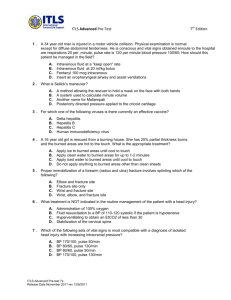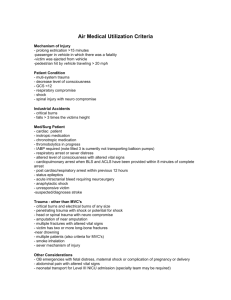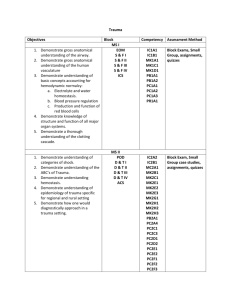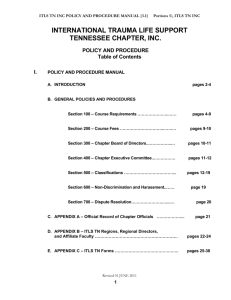ITLS Advanced Pre-Test
advertisement
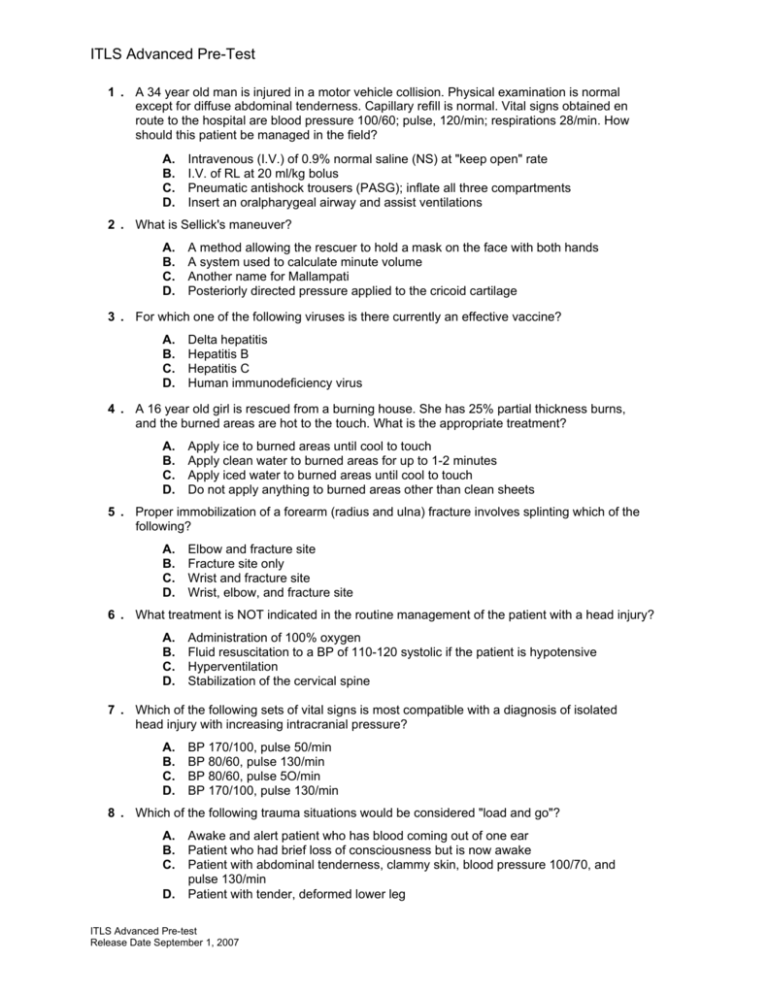
ITLS Advanced Pre-Test 1 . A 34 year old man is injured in a motor vehicle collision. Physical examination is normal except for diffuse abdominal tenderness. Capillary refill is normal. Vital signs obtained en route to the hospital are blood pressure 100/60; pulse, 120/min; respirations 28/min. How should this patient be managed in the field? A. B. C. D. Intravenous (I.V.) of 0.9% normal saline (NS) at "keep open" rate I.V. of RL at 20 ml/kg bolus Pneumatic antishock trousers (PASG); inflate all three compartments Insert an oralpharygeal airway and assist ventilations 2 . What is Sellick's maneuver? A. B. C. D. A method allowing the rescuer to hold a mask on the face with both hands A system used to calculate minute volume Another name for Mallampati Posteriorly directed pressure applied to the cricoid cartilage 3 . For which one of the following viruses is there currently an effective vaccine? A. B. C. D. Delta hepatitis Hepatitis B Hepatitis C Human immunodeficiency virus 4 . A 16 year old girl is rescued from a burning house. She has 25% partial thickness burns, and the burned areas are hot to the touch. What is the appropriate treatment? A. B. C. D. Apply ice to burned areas until cool to touch Apply clean water to burned areas for up to 1-2 minutes Apply iced water to burned areas until cool to touch Do not apply anything to burned areas other than clean sheets 5 . Proper immobilization of a forearm (radius and ulna) fracture involves splinting which of the following? A. B. C. D. Elbow and fracture site Fracture site only Wrist and fracture site Wrist, elbow, and fracture site 6 . What treatment is NOT indicated in the routine management of the patient with a head injury? A. B. C. D. Administration of 100% oxygen Fluid resuscitation to a BP of 110-120 systolic if the patient is hypotensive Hyperventilation Stabilization of the cervical spine 7 . Which of the following sets of vital signs is most compatible with a diagnosis of isolated head injury with increasing intracranial pressure? A. B. C. D. BP 170/100, pulse 50/min BP 80/60, pulse 130/min BP 80/60, pulse 5O/min BP 170/100, pulse 130/min 8 . Which of the following trauma situations would be considered "load and go"? A. B. C. D. Awake and alert patient who has blood coming out of one ear Patient who had brief loss of consciousness but is now awake Patient with abdominal tenderness, clammy skin, blood pressure 100/70, and pulse 130/min Patient with tender, deformed lower leg ITLS Advanced Pre-test Release Date September 1, 2007 ITLS Advanced Pre-Test 9 . Which one of the following should be performed, at the scene of a "load and go", prior to moving the trauma patient to the ambulance? A. B. C. D. Apply traction splint for femur fracture Decompress tension pneumothorax Initiate intravenous line Obtain vital signs 10 . Which one of the following is a reason to interrupt the initial assessment? A. B. C. D. Cardiac arrest Multiple open (compound) fractures Severe head injury with brain tissue visible Severe shock 11 . A 24 year old woman is found lying on the sidewalk after jumping from a fourth story window. She is hypotensive, diaphoretic, tachycardic, and unconscious. Injuries include open skull fracture, pelvis fractures, and flail chest. What should be your goal for your time? A. B. C. D. 5 minutes or less 5 to 10 minutes 10 to 15 minutes As long as necessary to assess and stabilize the patient 12 . Which of the following injuries would change an otherwise stable trauma patient's category from "stable" to "load and go"? A. B. C. D. Bilateral clavicle fractures Bilateral femur fractures Bilateral humerus fractures Bilateral tibia fractures 13 . What is most commonly injured, during a fall from a height, of an infant? A. B. C. D. Head Chest Abdomen Extremities 14 . What site is first choice for pediatric intraosseous infusion? A. B. C. D. Proximal tibia Distal humerus Proximal femur Distal fibula 15 . Which of the following will generally suffer the LEAST structural damage from a gunshot wound from a rifle? A. B. C. D. Spleen Kidney Liver Lung 16 . A 34 year old man has a gunshot wound to the right groin area. Arterial bleeding, which cannot be controlled with direct pressure, is coming from the wound. The patient appears confused, diaphoretic, and has weak peripheral pulses. What is the appropriate fluid resuscitation for this patient? A. B. C. D. I.V. at "keep open" rate Apply a hemostatic agent and gain IV access given enough fluid to maintain peripheral pulses I.V. wide open rate; give at least two liters, then reassess patient No I.V. should be started in this situation ITLS Advanced Pre-test Release Date September 1, 2007 ITLS Advanced Pre-Test 17 . Which one of the following is typically associated with, post-traumatic hemorrhage, EARLY shock? A. B. C. D. Ventricular dysrhythmias Hypotension Loss of 30% to 45% of blood volume Larrowed pulse pressure 18 . Among the following, what is the most common cause of preventable trauma death in the injured adult patient? A. B. C. D. Airway obstruction Cardiac tamponade Hemorrhagic shock Spinal injury 19 . In which of the following situations should an emergency rescue be used? A. B. C. D. Leaking antifreeze from radiator Paralyzed patient Presence of toxic fumes Pregnant patient 20 . Which of the following is most typical of early, neurogenic shock? A. B. C. D. Increased pulse, clammy skin Increased pulse, warm and dry skin Decreased pulse, clammy skin Decreased pulse, warm and dry skin 21 . A 23 year old man is injured in a motorcycle collision. The patient appears disoriented and grossly intoxicated. There is a large laceration on his scalp which is actively bleeding. The patient refuses treatment and threatens to call his lawyer if anyone touches him. What should you do? A. B. C. D. Allow the patient to phone his lawyer Have the patient sign a release form, then let him go Have the patient placed under protective custody then treat and transport the patient using restraints if necessary Wait until the patient passes out from his head injury or bleeding then transport 22 . Which of the following is an acceptable location to insert a needle when decompressing a tension pneumothorax? A. B. C. D. Directly under the bottom of the second rib, midclavicular line Directly under the bottom of the third rib, midclavicular line Directly over the top of the third rib, midaxillary line Directly over the top of the third rib, midclavicular line 23 . A 54 year old man is involved in a motor vehicle collision. The steering wheel is bent. During your initial assessment you note his skin is pale and his radial pulses are present. Breath sounds are clear, heart tones are not muffled. Which one of the following is most consistent with these findings? A. B. C. D. Cardiac contusion Traumatic aortic rupture Flail chest Tension pneumothorax 24 . What is the most common cause of cardiopulmonary arrest in the trauma patient? A. B. C. D. Brain injury Hypoxemia Myocardial contusion Ventricular arrhythmia ITLS Advanced Pre-test Release Date September 1, 2007 ITLS Advanced Pre-Test 25 . A 49 year old man is involved in a motor vehicle collision. First responders are doing CPR. Findings include a distended abdomen and obviously deformed pelvis and a quick look at the monitor shows asystole. Which of the following is the most appropriate act? A. B. C. D. Establish IV access and administer a 20mL/kg bolus Establish IV access and administer a 1 liter bolus Establish IV access and administer a 2-4 liter bolus Resuscitative efforts should not be started and the patient pronounced dead 26 . Which of the following statements concerning treatment of shock in the pregnant, burn patient is TRUE? A. B. C. D. Oxygen should be used sparingly so as to avoid oxygen toxicity to the fetus Pressor agents such as dopamine should be used to improve circulation to the fetus Volume replacement should be given earlier and in larger amounts to the pregnant, burn patient Volume replacement should be given more slowly so as to avoid fluid overloading the fetus 27 . Which area of the spine is most susceptible to injury in a rear-impact motor vehicle crash? A. B. C. D. Cervical Thoracic Lumbar Sacral-coccygeal 28 . An unrestrained 18 year old male on the way to a post-graduation party leaves the road, bounces through a ditch and hits a tree. You find him behind the bent steering wheel, unconscious, cool, pale and clammy, blue around the lips with labored respirations of 30 and shallow, thready radial pulses of about 120, distended neck veins, tracheal deviation to the right, an asymmetrical chest with absent breath sounds on the left. You assume he has a A. B. C. D. Cardiac tamponade Tension pneumothorax Massive hemothorax Simple pneumothorax 29 . Which one of the following mnemonics can be used to help predict which patients might potentially have difficult laryngoscopy and intubation? A. B. C. D. MMAP IPPV RSI BOOTS 30 . An unrestrained 18 year old male on the way to a post-graduation party leaves the road, bounces through a ditch and hits a tree. You find him behind the bent steering wheel, unconscious, cool, pale and clammy, with labored respirations of 30 and shallow, thready radial pulses of about 120, flat neck veins, trachea midline, an asymmetrical chest with absent breath sounds on the left. You assume he has a A. B. C. D. Cardiac tamponade Tension pneumothorax Massive hemothorax Simple pneumothorax ITLS Advanced Pre-test Release Date September 1, 2007 ITLS Advanced Pre-Test 31 . A 23 year old female has won the “Let’s-see-who-can-lean-the-farthest-backward-overthe-second-story-balcony-railing” contest. You arrive to find her boyfriend standing over her, holding two beers, as she lies on the grass under the balcony. She opens her eyes to voice, her skin is normal in color, respirations about 16 and unlabored, pulse 54 and a little weak at the wrist, with no external bleeding. She has flat neck veins, a normal chest and abdomen and a stable pelvis. First responders who arrived just before you tell you that her pulse ox reading is 94 and her BP is 74/30. If this is true, A. B. C. D. Hypovolemic shock Relative hypovolemic (high-space) shock Mechanical (obstructive) shock Cardiogenic shock 32 . A 23 year old female has won the “Let’s-see-who-can-lean-the-farthest-backward-overthe-second-story-balcony-railing contest. You arrive to find her boyfriend standing over her, holding two beers, as she lies on the grass under the balcony. She opens her eyes to voice, her skin is cool, clammy and ashen, respirations are rapid and shallow, radial pulses are too rapid to count and thready. There is no external bleeding. She has flat neck veins, a normal chest and abdomen and pelvis. Her boyfriend tells you that she has some kind of heart problem but he doesn’t know what. Placed on the monitor, she shows a wide-complex tachycardia of about 280. What kind of shock is she suffering? A. B. C. D. Hypovolemic shock Relative hypovolemic (high-space) shock Mechanical (obstructive) shock Cardiogenic shock 33 . Which of the following would be the most compelling reason to intubate a patient immediately? A. B. C. D. Snoring respirations Gurgling respirations Inability to ventilate (achieve chest rise) Traumatic arrest ITLS Advanced Pre-test Release Date September 1, 2007 ITLS Advanced Pre-Test 1. A B C D 25. A B C D 2. A B C D 26. A B C D 3. A B C D 27. A B C D 4. A B C D 28. A B C D 5. A B C D 29. A B C D 6. A B C D 30. A B C D 7. A B C D 31. A B C D 8. A B C D 32. A B C D 9. A B C D 33. A B C D 10. A B C D 11. A B C D 12. A B C D 13. A B C D 14. A B C D 15. A B C D 16. A B C D 17. A B C D 18. A B C D 19. A B C D 20. A B C D 21. A B C D 22. A B C D 23. A B C D 24. A B C D ITLS Advanced Pre-test Release Date September 1, 2007 ITLS Advanced Pre-Test Answer Key ITLS-Advanced Pre-Test Question Number Answer 1 2 3 4 5 6 7 8 9 10 11 12 13 14 15 16 17 18 19 20 21 22 23 24 25 26 27 28 29 30 31 32 33 A D B B D C A C B A A B A A D B D C C D C D A B D C A B A C B D C ITLS Advanced Pre-test Release Date September 1, 2007 Topic Objective Abdominal Trauma Airway Blood/Fluid Precautions Burns Extremity Trauma Head Trauma Head Trauma Initial Assessment Initial Assessment Initial Assessment Initial Assessment Initial Assessment Pediatric Trauma Pediatric Trauma Scene Size-up Shock Shock Shock Spinal Trauma Spinal Trauma Substance Abuse Thoracic Trauma Thoracic Trauma Trauma Arrest Trauma Arrest Trauma in Pregnancy Scene Size-up Thoracic Trauma Airway Thoracic Trauma Shock Shock Airway 13.6 - page 203 4.6 - page 62 22.4 - page 264 16.6 - page 245 14.2a - page 218 10.6 - page 145 10.5 - page 145 2.6 - page 37 2.6 - page 37 2.2 - page 29 2.6 - page 29 2.6 - page 37 17.2 - page 261 9.2 - page 138 1.12 - page 21 8.5b - page 130 8.4 - page 122 8.4 - page 124 11.5 - page 167 11.8 - page 166 20.3 - page 302 7.3 - page 116 6.11 - page 107 21.2 - page 308 21.1 - page 308 19.5 - page 291 1.9 - page 7 8.3 - page 123 4.2 - page 68 8.3 - page 123 8.3 - page 123 8.3 - page 123 4.5 - page 74 ITLS Advanced Pre-Test ITLS-Advanced Pre-Test Analysis Cut Score Nadelski-Gross (N-G) N-G with Smith Factor 65.5% 65.8% Answer Distribution Answer Number of Questions Percent A 9 27.3% B 8 24.2% C 8 24.2% D 8 24.2% Total Number of 33 Distribution by Level Course Level Number of Percent Advanced 10 30.3% Basic 23 69.7% Topic Distribution Topic Abdominal Trauma Airway Blood/Fluid Precautions Burns Extremity Trauma Head Trauma Initial Assessment Pediatric Trauma Scene Size-up Shock Spinal Trauma Substance Abuse Thoracic Trauma Trauma Arrest Trauma In Pregnancy Reading Level* (Flesch-Kincaid) Avg Reading Level*: 9.7 Min Reading Level*: 4.4 Max Reading Level*: 16.2 StDev Reading Level*: 2.3 *Stem only ITLS Advanced Pre-test Release Date September 1, 2007 Number of Percent 1 3 1 1 1 2 5 2 2 5 2 1 4 2 1 3.0% 9.1% 3.0% 3.0% 3.0% 6.1% 15.2% 6.1% 6.1% 15.2% 6.1% 3.0% 12.1% 6.1% 3.0%


